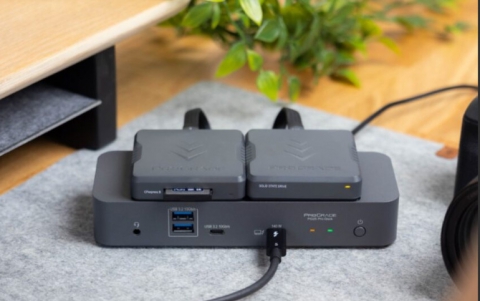
Panasonic Develops High Efficiency White OLED for Lighting
Panasonic has developed a white Organic Light Emitting Diode (OLED) with "the world's highest luminous efficiency of 114 lm/W (light-emitting area of 1 cm²)," according to the company.
In addition, a luminous efficiency of 110 lm/W has also been achieved with a device with a larger emitting area of 25 cm². In order to achieve such a level of high efficiency with the OLED, the company focused on "light extraction technology" and the "all phosphorescent white OLED technology" (technology for the multilayering of the organic emitting layer).
OLEDs are capable of emitting any color including white when a voltage is applied by combining organic materials that emit various colors such as red, green, and blue. The soft surface luminescence makes OLEDs suitable for lighting a wide area, and along with the benefits of being not overly bright when viewed directly and a thin and lightweight structure, they are receiving attention as the next generation light source. Lighting devices equipped with the high efficiency OLEDs are considered to achieve a luminous efficiency comparable to or higher than that of fluorescent lamps (approx. 60-80 lm/W) or LED lighting fixtures (approx. 80 lm/W) currently available in the market.
Typically, the organic light emitting layers have higher refractive indices than those of a glass used for substrate and air, and only about 20% of the total generated light can be extracted because of the total internal reflection at interfaces. Although a variety of technologies have been developed, including a light extraction film attached onto the substrate and a light-scattering structure placed between organic layers and the substrate, the light extraction efficiency stayed below 40%.
Panasonic says that its new OLED has a light extraction efficiency of about 50%, while it also has a lifetime of over 100,000 hours.

These features have been achieved with the following technologies:
- Built-up Light Extraction Substrate (BLES) technology by the optimized arrangement of the film, glass and air for the suppression of light confinement in the OLED.
- Optimal design of stacked organic emitting layers with high-efficiency phosphorescent materials.
The development was conducted in the "Fundamental Technology Development of Next Generation Lighting of High-efficiency and High-quality" project since March 2010 under a contract with the New Energy and Industrial Technology Development Organization, with Idemitsu Kosan Co., Ltd, TAZMO CO., LTD., Choshu Industry Co., Ltd., Yamagata University, and Aoyama Gakuin University. The high-efficiency phosphorescent materials were provided by the Universal Display Corporation of the United States.
OLEDs are capable of emitting any color including white when a voltage is applied by combining organic materials that emit various colors such as red, green, and blue. The soft surface luminescence makes OLEDs suitable for lighting a wide area, and along with the benefits of being not overly bright when viewed directly and a thin and lightweight structure, they are receiving attention as the next generation light source. Lighting devices equipped with the high efficiency OLEDs are considered to achieve a luminous efficiency comparable to or higher than that of fluorescent lamps (approx. 60-80 lm/W) or LED lighting fixtures (approx. 80 lm/W) currently available in the market.
Typically, the organic light emitting layers have higher refractive indices than those of a glass used for substrate and air, and only about 20% of the total generated light can be extracted because of the total internal reflection at interfaces. Although a variety of technologies have been developed, including a light extraction film attached onto the substrate and a light-scattering structure placed between organic layers and the substrate, the light extraction efficiency stayed below 40%.
Panasonic says that its new OLED has a light extraction efficiency of about 50%, while it also has a lifetime of over 100,000 hours.

These features have been achieved with the following technologies:
- Built-up Light Extraction Substrate (BLES) technology by the optimized arrangement of the film, glass and air for the suppression of light confinement in the OLED.
- Optimal design of stacked organic emitting layers with high-efficiency phosphorescent materials.
The development was conducted in the "Fundamental Technology Development of Next Generation Lighting of High-efficiency and High-quality" project since March 2010 under a contract with the New Energy and Industrial Technology Development Organization, with Idemitsu Kosan Co., Ltd, TAZMO CO., LTD., Choshu Industry Co., Ltd., Yamagata University, and Aoyama Gakuin University. The high-efficiency phosphorescent materials were provided by the Universal Display Corporation of the United States.





















